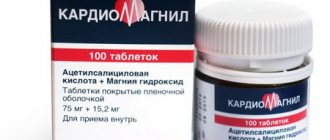Treatment of chronic gastritis and stomach ulcers is rarely complete without a drug such as Omeprazole (with the active ingredient omeprazole). This is a proton pump inhibitor, which reduces the acidity of gastric juice, relieves inflammation from the gastric mucosa and speeds up recovery. Neutralization of gastric juice is a necessary component of the treatment of gastritis. How to take Omeprazole for gastritis?
Why take Omeprazole for gastritis?
Omeprazole is a drug for the treatment of stomach and duodenal ulcers.
Omeprazole is prescribed for stomach and duodenal ulcers, gastritis and duodenitis to neutralize the acidic environment.
Gastric juice contains hydrochloric acid, which must digest food, break it down, preparing it for the further digestion process.
The lump of food with gastric juice then enters the duodenum, where the digestion process continues with the help of enzymes contained in bile, hydrochloric acid is neutralized, and the food moves further through the intestines.
If the acidity of gastric juice increases, it begins to affect the walls of the stomach, irritating them, which leads to hyperacid gastritis. To relieve inflammation from the gastric mucosa, the acidity of gastric juice must be reduced.
Omeprazole for gastritis, entering the stomach, affects the pH of gastric juice, neutralizes the effect of hydrochloric acid and creates favorable conditions for the healing of the stomach walls. The drug affects not only the contents of the stomach, but also the glands themselves, the cells of the gastric walls, blocking the production of acid.
This explains the effectiveness of the drug and its popularity among people suffering from ulcers and gastritis. When used correctly and the optimal dosage is determined, the drug has the following effects:
- Relieves pain syndrome. Acid, irritating the walls of the stomach, causes pain, cramps, and hunger pains. Omeprazole does not have an analgesic effect, but relieves pain by eliminating the irritant.
- Normalizes stool. Increased acidity often causes various disruptions in the intestines: constipation, diarrhea. Omeprazole relieves unpleasant symptoms.
- Eliminates nausea and sour belching. Gastritis is accompanied by belching with an unpleasant sour odor and nausea due to the effects of acid. Omeprazole helps eliminate these symptoms, but for the best effect, treatment should be comprehensive and accompanied by a diet.
- Eliminates heartburn. Omeprazole, by reducing the acidity of gastric juice, prevents its release into the esophagus and relieves heartburn, which is a frequent companion of gastritis.
Instructions for use of Omeprazole
Omeprazole is intended for both adults and children over 5 years old.
The drug is prescribed to children over 5 years of age and adults during the following diseases:
- For prevention if the patient has a chronic ulcer, stress ulcer or aspirin ulcer
- Treatment of polyendocrine adenomatosis together with other drugs, that is, in complex treatment
- Treatment of gastropathy that has formed after long-term use of anti-inflammatory drugs
- During heartburn, if it has been bothering the patient for more than two days
- For the treatment of inflammation of the gastric tract, duodenum and ulcers.
Contraindications and side effects
Omeprazole should not be taken by pregnant women.
Side effects are rare when taking Omeprazole. In some cases, diarrhea, dry mouth, increased thirst, headache, and fatigue occur.
An allergic reaction can manifest itself in the form of a rash, itching, hives, and swelling. If such side effects are observed, the drug will have to be stopped.
There are practically no side effects if the dosage and doctor’s recommendations are followed. If unpleasant symptoms appear, you must stop taking the drug or reduce the dosage; the side effects will quickly disappear (within two weeks without additional treatment). Omeprazole, like any drug, has its contraindications.
- Pregnancy and lactation. For pregnant women with chronic gastritis, taking Omeprazole is a relative contraindication. In rare cases, under the supervision of a doctor, it is allowed to take the drug, but more often only a gentle diet and safer drugs are prescribed, for example, Almagagel.
- Individual intolerance. If individual intolerance to Omeprozole is observed, it is replaced with an analogue drug.
- Children's age up to 12 years. Children's age is considered a contraindication, but in rare cases, with severe esophagitis and peptic ulcer in a child, Omeprazole is prescribed to children over one year of age. The dosage is determined taking into account the child’s weight: 10-20 mg 1-2 times a day.
- Severe liver and kidney diseases. The drug is destroyed in the liver and excreted by the kidneys in the urine. With serious pathologies of these organs, the removal of Omeprazole from the body becomes difficult, which leads to various side effects and complications. If necessary, patients with renal and liver failure are prescribed Omerazole in a reduced dosage.
- Under no circumstances should you take the drug without examination and diagnosis by a doctor. Drinking Omeprazole for any abdominal pain is dangerous, since even when relief occurs, the clinical picture is blurred. As a result, you may miss a serious illness, such as a stomach ulcer or malignant tumor.
Omeprazol
Inside. Omeprazole capsules are recommended to be taken in the morning; the capsule should be swallowed whole with liquid. Capsules must not be chewed or crushed.
Adults
Duodenal ulcer
Patients with an active duodenal ulcer are recommended to take Omeprazole 20 mg once daily. The drug provides rapid relief of symptoms. In most patients, ulcer healing occurs within 2 weeks. In cases where complete healing of the ulcer does not occur within 2 weeks, healing is achieved with a subsequent 2-week intake of the drug Omeprazole.
Patients with duodenal ulcers that are poorly responsive to treatment are usually prescribed omeprazole 40 mg once daily; Ulcer healing usually occurs within 4 weeks.
Stomach ulcer
The recommended dose is Omeprazole 20 mg once a day. The drug provides rapid relief of symptoms. In most patients, cure occurs within 4 weeks. In cases where complete healing does not occur after the first course of taking the drug, a repeated 4-week course of treatment is usually prescribed, during which healing is achieved.
Patients with gastric ulcers that are poorly responsive to treatment are usually prescribed omeprazole 40 mg once a day; healing is usually achieved within 8 weeks.
To prevent relapses, patients with gastric ulcers are recommended to take Omeprazole 20 mg once a day. If necessary, the dose can be increased to 40 mg 1 time per day.
NSAID-associated ulcers and erosions of the stomach and duodenum
In the presence of NSAID-associated gastric, duodenal ulcers or gastroduodenal erosions in patients with ongoing NSAID therapy or after its cessation, the recommended dose of Omeprazole is 20 mg once a day. The drug provides rapid relief of symptoms; in most patients, cure occurs within 4 weeks. In those patients who do not heal during the initial period of therapy, healing is usually achieved with a repeat dose of the drug for 4 weeks.
For the prevention of ulcers and erosions of the stomach and duodenum and symptoms of dyspepsia associated with taking NSAIDs, the recommended dose of Omeprazole is 20 mg 1 time per day.
Eradication of Helicobacter pylori in peptic ulcer disease (in combination with appropriate antibacterial therapy)
Helicobacter pylori eradication regimens for peptic ulcer disease
Three-component treatment regimen:
omeprazole 20 mg, amoxicillin 1 g and clarithromycin 500 mg. Take all medications 2 times a day for one week, or
omeprazole 20 mg, metronidazole 400 mg (or tinidazole 500 mg) and clarithromycin 250 mg. Take all medications 2 times a day for one week, or
omeprazole 40 mg once a day, as well as amoxicillin 500 mg and metronidazole 400 mg 3 times a day for one week.
Two-component treatment regimen:
omeprazole 40-80 mg daily and amoxicillin 1.5 g daily (dose should be divided into parts) for two weeks. During clinical trials, amoxicillin was used at a daily dose of 1.5-3 g, omeprazole 40 mg once a day and clarithromycin 500 mg 3 times a day for 2 weeks.
To ensure complete healing, further treatment should be carried out in accordance with the recommendations in the sections “Duodenal Ulcer” and “Gastric Ulcer”.
In cases where, after completing a course of treatment, the test for Helicobacter pylori remains positive, the course of treatment can be repeated.
Reflux esophagitis
The recommended dose is one capsule of Omeprazole 20 mg once a day. The drug provides rapid relief of symptoms. In most patients, cure occurs within 4 weeks. In cases where, after the first course of taking the drug, complete cure does not occur, a repeated 4-week course of treatment is usually prescribed, during which a cure is achieved.
For patients with severe reflux esophagitis, omeprazole 40 mg once daily is recommended; cure usually occurs within 8 weeks.
Symptomatic gastroesophageal reflux disease
The recommended dose is Omeprazole 20 mg once a day. The drug provides rapid relief of symptoms. If after 4 weeks of treatment (Omeprazole 20 mg 1 time per day) symptoms do not disappear, additional examination of the patient is recommended.
Dyspepsia associated with hyperacidity
To relieve pain and/or eliminate discomfort in the epigastric region, with or without heartburn, Omeprazole 20 mg is prescribed once a day. If after 4 weeks of treatment (Omeprazole 20 mg 1 time per day) symptoms do not disappear, additional examination of the patient is recommended.
Zollinger-Ellison syndrome
For patients with Zollinger-Ellison syndrome, the drug is prescribed in an individual dosage. Treatment is continued according to clinical indications for as long as necessary. The recommended starting dose is Omeprazole 60 mg daily. In all patients with severe forms of the disease, as well as in cases where other therapeutic methods did not lead to the desired result, the use of the drug was effective in more than 90% of patients when taking 20-120 mg of omeprazole daily. In cases where the daily dose of the drug exceeds 80 mg, the dose should be divided into two parts and taken 2 times a day.
Children and teenagers
Reflux esophagitis and symptomatic gastroesophageal reflux disease
Children over 2 years of age with a body weight of more than 20 kg are prescribed Omeprazole at a dose of 20 mg once a day. If necessary, the dose can be increased to 40 mg once a day. The recommended duration of treatment in case of reflux esophagitis is 4-8 weeks. The recommended duration of treatment for symptomatic gastroesophageal reflux disease is 2-4 weeks. If after 2-4 weeks of treatment control of the symptoms of the disease has not been achieved, additional examination of the patient is recommended.
Duodenal ulcer caused by Helicobacter pylori
When choosing a treatment regimen, official national, regional and local recommendations regarding the resistance of microorganisms to antibacterial agents, the duration of therapy (most often 7 days, but in some cases up to 14 days) and the correct use of antibacterial drugs should be taken into account.
Therapy must be carried out under the supervision of a specialist.
For children over 4 years of age, the following treatment regimen is recommended:
| Body mass | Treatment regimen |
| 31-40 kg | omeprazole 20 mg, amoxicillin 750 mg and clarithromycin 7.5 mg/kg. Take all medications 2 times a day for a week. |
| > 40 kg | omeprazole 20 mg, amoxicillin 1 g and clarithromycin 500 mg. Take all medications 2 times a day for a week. |
Special patient groups
Renal dysfunction
For patients with impaired renal function, no dose adjustment is required.
Liver dysfunction
In patients with impaired liver function, the bioavailability and plasma half-life of omeprazole are increased. In this regard, a dose of 20 mg per day is sufficient.
Elderly patients
For elderly patients, no dose adjustment is required.
What can replace Omeprazole in the treatment of gastritis?
Orthanol - can be a replacement for the drug Omeprazole.
In case of individual intolerance to the drug, it can be replaced with an analogue recommended by the doctor. Omeprazole analogues also reduce the acidity of gastric juice and help relieve inflammation of the gastric mucosa.
- Omez. A drug based on omeprazole, often prescribed for inflammatory diseases of the stomach and duodenum. This is an Indian-made drug; it is available not only in tablets, but also in injections. Side effects include nausea, abdominal pain, constipation or diarrhea, arrhythmia, allergic reaction, and drowsiness.
- Orthanol. This drug also contains omeprazole and has a relatively low price, but differs in that the maximum concentration of the drug is reached over a longer period of time.
- Rabelok. The drug is based on rabeprazole, available in the form of tablets and solution for injection. Not recommended during pregnancy, breastfeeding, or individual intolerance to the drug.
- Ontime. The drug contains rabeprazole, but of all analogues it has the lowest ability to penetrate tissue (bioavailability). Recommended for hyperacid gastritis, gastric ulcers and erosion, GERD, as well as in combination with other drugs for the eradication of Helicobacter pylori. The drug is not used in pediatric practice and is extremely rarely prescribed to children.
- Hasek. A drug based on omeprazole. The maximum effect is observed on the fourth day after starting treatment. Available in capsule form for oral administration. The drug Gasec-10 is taken 1-2 capsules per day. The drug is not recommended for people with fructose intolerance.
All of the drugs listed contain either omeprazole or rabeprazole. In case of severe side effects while taking omeprazole, they are replaced with more gentle drugs that envelop and protect the walls of the stomach: Reni, Gastal, Almagel, Maalox.
Contraindications
Omeprazole should not be taken by patients who cannot tolerate at least one of the components of this drug. In addition, it should not be taken during pregnancy, or rather, it is not recommended, since in some cases it is also prescribed to pregnant women. But in the first trimester, it is strictly forbidden to take the drug, as it can cause disruption in the development of the fetus. Therefore, Omeprazole is prescribed to pregnant women only when the benefits of its use are significantly higher than the possible side effects.
The medicine is not prescribed to nursing mothers, as it penetrates very quickly into the blood and, accordingly, into breast milk. As already mentioned, the drug lowers the level of acidity in the stomach, so it is not recommended to take it if the patient is worried about gastritis with low acidity or atrophic gastritis. Also, those who suspect gastric cancer should not take this medicine.
Because Omeprazole may lead to incorrect symptoms, leading to misdiagnosis. Therefore, if you are undergoing examination, then avoid taking this drug. Also, during research it was revealed that this medicine promotes the growth of oncological tumors. Before taking the drug, make sure that you do not have any of the following symptoms:
- Tumor in the digestive tract
- Liver failure
- Infections in the stomach: salmonella, compylobacter.
Why is heartburn dangerous?
Many people neglect heartburn and make a mistake, especially if the burning sensation bothers you often. The danger of heartburn is not only that it may hide the diseases described above, which require proper diagnosis and treatment. The upward release of gastric juice itself greatly irritates the esophageal mucosa, contributing to the appearance of inflammation. This is fraught with the development of diseases such as esophagitis, erosions and peptic ulcers. Long-term chronic inflammation of the esophagus leads to a precancerous condition known as Barrett's esophagus.
What to do if you have heartburn?
If you are worried about heartburn, then first of all you should get rid of all the factors that contribute to its occurrence. Eat 3-4 times a day, limit your consumption of too fatty and fried foods, smoked foods, and sour foods. Get rid of bad habits (smoking, alcohol), and also eliminate coffee and carbonated drinks from your diet.
If, despite changing your lifestyle, heartburn still bothers you, then medications will come to the rescue. Currently, two main groups of drugs are used for heartburn:
- Antacids (from the Greek “anti” - against; from the Latin “acidus” - acid). These are drugs that neutralize hydrochloric acid in the stomach4. In other words, antacids treat the symptom but not the cause of heartburn. The duration of the neutralizing effect of antacids is several hours while they are in the stomach. For this reason, antacids must be taken several times a day.
- Proton pump inhibitors (PPIs). As mentioned above, the production of hydrochloric acid in the stomach is carried out by special (parietal) cells of the gastric glands. The central link in the synthesis of hydrochloric acid is the proton (or hydrogen) pump, which ensures the transfer of hydrogen ions H+ through the membrane into the gastric space. PPIs inhibit the activity of the proton pump, resulting in decreased production of hydrochloric acid5.









